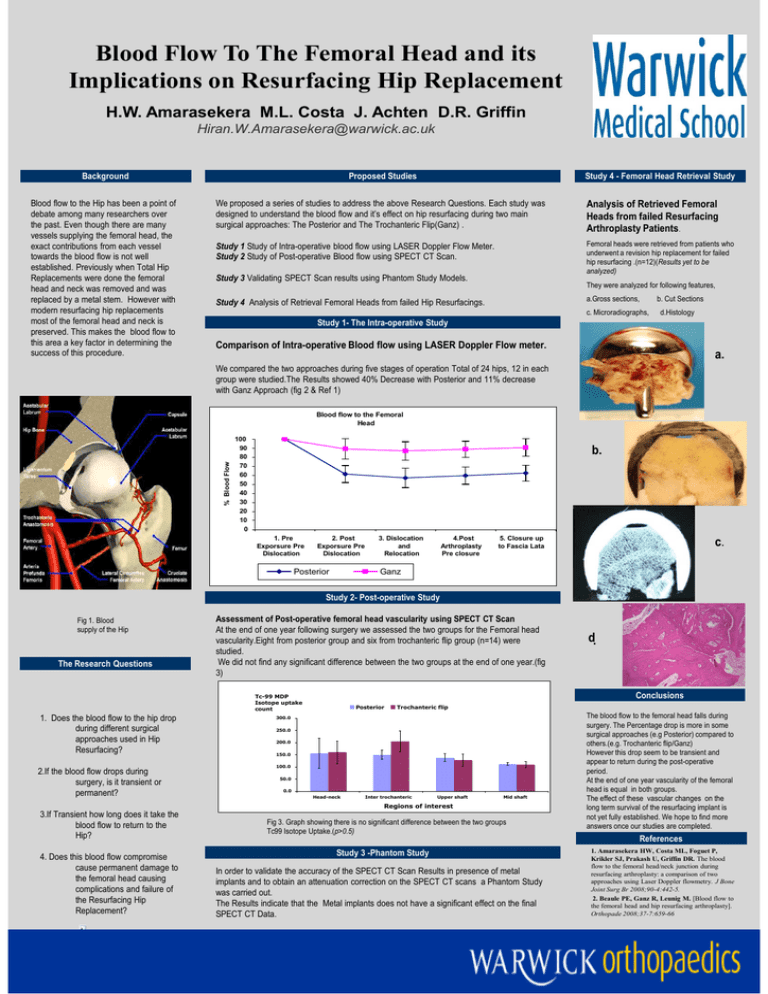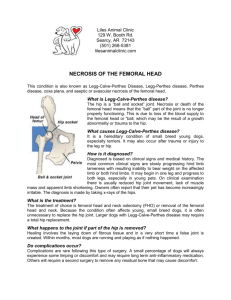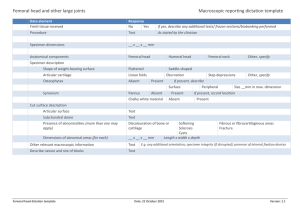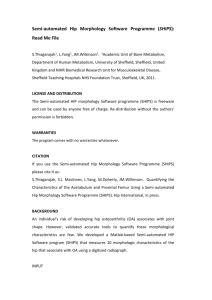Blood Flow To The Femoral Head and its
advertisement

Blood Flow To The Femoral Head and its Implications on Resurfacing Hip Replacement H.W. Amarasekera M.L. Costa J. Achten D.R. Griffin Hiran.W.Amarasekera@warwick.ac.uk Background Proposed Studies Study 4 - Femoral Head Retrieval Study Blood flow to the Hip has been a point of debate among many researchers over the past. Even though there are many vessels supplying the femoral head, the exact contributions from each vessel towards the blood flow is not well established. Previously when Total Hip Replacements were done the femoral head and neck was removed and was replaced by a metal stem. However with modern resurfacing hip replacements most of the femoral head and neck is preserved. This makes the blood flow to this area a key factor in determining the success of this procedure. We proposed a series of studies to address the above Research Questions. Each study was designed to understand the blood flow and it’s effect on hip resurfacing during two main surgical approaches: The Posterior and The Trochanteric Flip(Ganz) . Analysis of Retrieved Femoral Heads from failed Resurfacing Arthroplasty Patients. Study 1 Study of Intra-operative blood flow using LASER Doppler Flow Meter. Study 2 Study of Post-operative Blood flow using SPECT CT Scan. Femoral heads were retrieved from patients who underwent a revision hip replacement for failed hip resurfacing .(n=12)(Results yet to be analyzed) Study 3 Validating SPECT Scan results using Phantom Study Models. They were analyzed for following features, a.Gross sections, Study 4 Analysis of Retrieval Femoral Heads from failed Hip Resurfacings. c. Microradiographs, b. Cut Sections d.Histology Study 1- The Intra-operative Study Comparison of Intra-operative Blood flow using LASER Doppler Flow meter. a. We compared the two approaches during five stages of operation Total of 24 hips, 12 in each group were studied.The Results showed 40% Decrease with Posterior and 11% decrease with Ganz Approach (fig 2 & Ref 1) % Blood Flow Blood flow to the Femoral Head 100 90 80 70 60 50 40 30 20 10 0 b. 1. Pre Exporsure Pre Dislocation 2. Post Exporsure Pre Dislocation Posterior 3. Dislocation and Relocation 4.Post Arthroplasty Pre closure c. 5. Closure up to Fascia Lata Ganz Study 2- Post-operative Study Fig 1. Blood supply of the Hip The Research Questions Assessment of Post-operative femoral head vascularity using SPECT CT Scan At the end of one year following surgery we assessed the two groups for the Femoral head vascularity.Eight from posterior group and six from trochanteric flip group (n=14) were studied. We did not find any significant difference between the two groups at the end of one year.(fig 3) Conclusions Tc-99 MDP Isotope uptake count 1. Does the blood flow to the hip drop during different surgical approaches used in Hip Resurfacing? 2.If the blood flow drops during surgery, is it transient or permanent? 3.If Transient how long does it take the blood flow to return to the Hip? 4. Does this blood flow compromise cause permanent damage to the femoral head causing complications and failure of the Resurfacing Hip Replacement? d. Posterior Trochanteric flip 300.0 250.0 200.0 150.0 100.0 50.0 0.0 Head-neck Inter trochanteric Upper shaft Mid shaft Regions of interest Fig 3. Graph showing there is no significant difference between the two groups Tc99 Isotope Uptake.(p>0.5) Study 3 -Phantom Study In order to validate the accuracy of the SPECT CT Scan Results in presence of metal implants and to obtain an attenuation correction on the SPECT CT scans a Phantom Study was carried out. The Results indicate that the Metal implants does not have a significant effect on the final SPECT CT Data. The blood flow to the femoral head falls during surgery. The Percentage drop is more in some surgical approaches (e.g Posterior) compared to others.(e.g. Trochanteric flip/Ganz) However this drop seem to be transient and appear to return during the post-operative period. At the end of one year vascularity of the femoral head is equal in both groups. The effect of these vascular changes on the long term survival of the resurfacing implant is not yet fully established. We hope to find more answers once our studies are completed. References 1. Amarasekera HW, Costa ML, Foguet P, Krikler SJ, Prakash U, Griffin DR. The blood flow to the femoral head/neck junction during resurfacing arthroplasty: a comparison of two approaches using Laser Doppler flowmetry. J Bone Joint Surg Br 2008;90-4:442-5. 2. Beaule PE, Ganz R, Leunig M. [Blood flow to the femoral head and hip resurfacing arthroplasty]. Orthopade 2008;37-7:659-66






